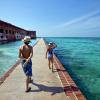Jeff Klinkenberg
No need to be scared. Go ahead and drive over the Seven Mile Bridge. It’s modern now.
Finished in 1982, the longest bridge in the Florida Keys is wide enough to give a motorist room to pull over to change a flat tire and steal many glances at the perfectly green water.
The original bridge I grew up crossing was less friendly, narrow and harrowing, requiring concentration and a good grip on the steering wheel as you left Marathon Key on your way to Key West and suddenly found yourself driving over the ocean. Smart drivers kept eyes on the oncoming traffic instead of nature. The bridge seemed too constricted for two passing cars.
Completed in 1912, the old structure, initially a railroad bridge, was known as the “Eighth Wonder of the World’’ because even attempting to build something so ambitious over miles of open water and a soft bottom in a harsh tropical climate seemed a bit nutty.
As you drive over the modern bridge now you can see the old bridge nearby. Only the pelicans and great blue herons use it as a perch. But for some of us, the old bridge reminds us that the Keys have always been a place for dreamers and schemers who didn’t like to be told “You can never do that.”
Henry Morrison Flagler, a craggy, white-haired business genius who made his fortune in the oil business, hadn’t gotten rich by being cautious. In the 19th century he came to Florida, built a hotel in St. Augustine and founded the Florida East Coast Railway. By 1896, his train was going all the way to Miami. That wasn’t good enough. He wanted his railroad to go another 100 miles or so south – to Key West.
“Flagler’s Folly.’’ That’s what a lot of folks called it. “Just watch me,’’ was Flagler’s credo.
Starting in 1905, he spent $30 million of his own money to lay track and build dozens of bridges, hiring 4,000 workers for the small fortune of $1.50 a day. They had to wade through swamps where boots sank into the mud as crocodiles slipped off the banks. Some workers died of heatstroke and snakebite. Everybody was bitten by mosquitoes. Folks were chronically hungry and thirsty.
In 1908, the workers reached Marathon Key where about seven miles of open water lay ahead. Flagler’s civil engineers had to invent new technology as they went along. At their disposal were two steamships, tugboats, paddle wheelers, dredges, launches and a catamaran. Flagler sent away to England for a kind of cement capable of drying underwater. Divers wearing helmets positioned underwater structures. Barges swung in the current as workers tried to keep their balance.
They slept in tents and in bunkhouses Flagler built on Pigeon Key, about two miles from shore. The bunkhouses are still there. A ferry will take you to the island and a guide will show you around. Do it.
You’ll learn that on Jan. 28, 1916, the train rumbled to a stop in Key West. Flagler, 82, stepped out of his private car with his young wife. “Now I can die happy,” Flagler whispered to a friend. “My dream is fulfilled.’’
Dreams die hard in the Keys.
The death of Flagler’s railroad happened on Labor Day in 1935. It began when the barometer started dropping. Nobody knew that the most powerful hurricane to ever hit the United States was on its way.
It swept across Matecumbe Key, in the Central Keys, that evening. Officials from the railroad had dispatched a train to evacuate residents and 800 World War I veterans who were living in tents and working on a new road near the railroad tracks.
The train arrived too late.
Years ago, I spent a day with Bernie Russell, whose family – 53 brothers, sisters, aunts, uncles and cousins – lived on Matecumbe as commercial fishermen and Key lime growers. He told me what happened as the eye of the hurricane got closer.
The wind rose and the tide creeped into buildings. Russell, two siblings and his parents, abandoned a crumbling fruit packing house and made a run for the railroad tracks at the high point of the island.
In the 200-mph winds, Bernie watched his mother blow away. He never saw her again. Other relatives disappeared in the howl of wind-driven rain. Somehow he and his dad survived. In the morning, they saw that virtually every palm tree on the island was snapped in half. The railroad cars were blown off the track. Only the locomotive, which weighed 320,000 pounds, stood up to the storm.
More than 400 bodies were recovered. Most had drowned though others were killed by flying debris.
Bernie Russell lost more than 40 relatives.
The Flagler railroad was lost too.
Not every bit, but enough that the Florida East Coast Railway decided to end service to the Keys. It sold the railroad line to the U.S. Government. A roadway was placed over the surviving railroad bed and broken track became the guardrails on the new motorist bridges.
The Overseas Highway, as it still is called, opened in 1938.
I lived in Key West during the summer of 1954. I grew up in Miami, but the Keys remained my playground, a place to camp and fish and study nature and history.
When I was a kid, my dad would park the car at the end of Marathon and we’d carry our fishing poles and bait bucket out on the Seven Mile Bridge.
I don’t remember catching much. Just a few grunt and snapper. But it was a great adventure, standing on the long bridge, looking down into water clear enough to see passing sea turtles, hammerhead sharks, endangered sawfish.
The bridge was a good place for dreamers. It left its mark on me.
When I drive across the New Seven Mile Bridge now I crane my neck to look at the Old Seven Mile Bridge.
I see ghosts.
























